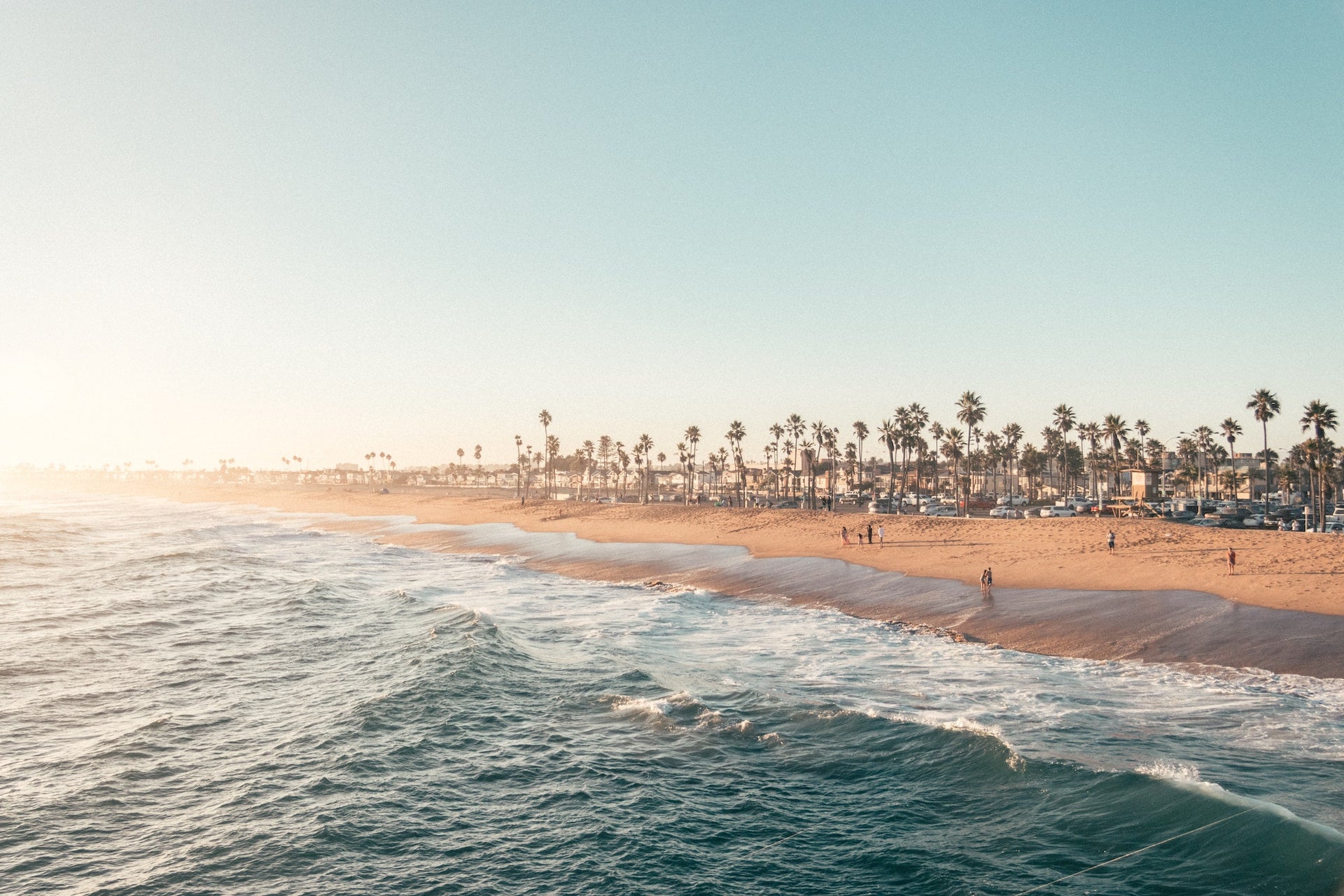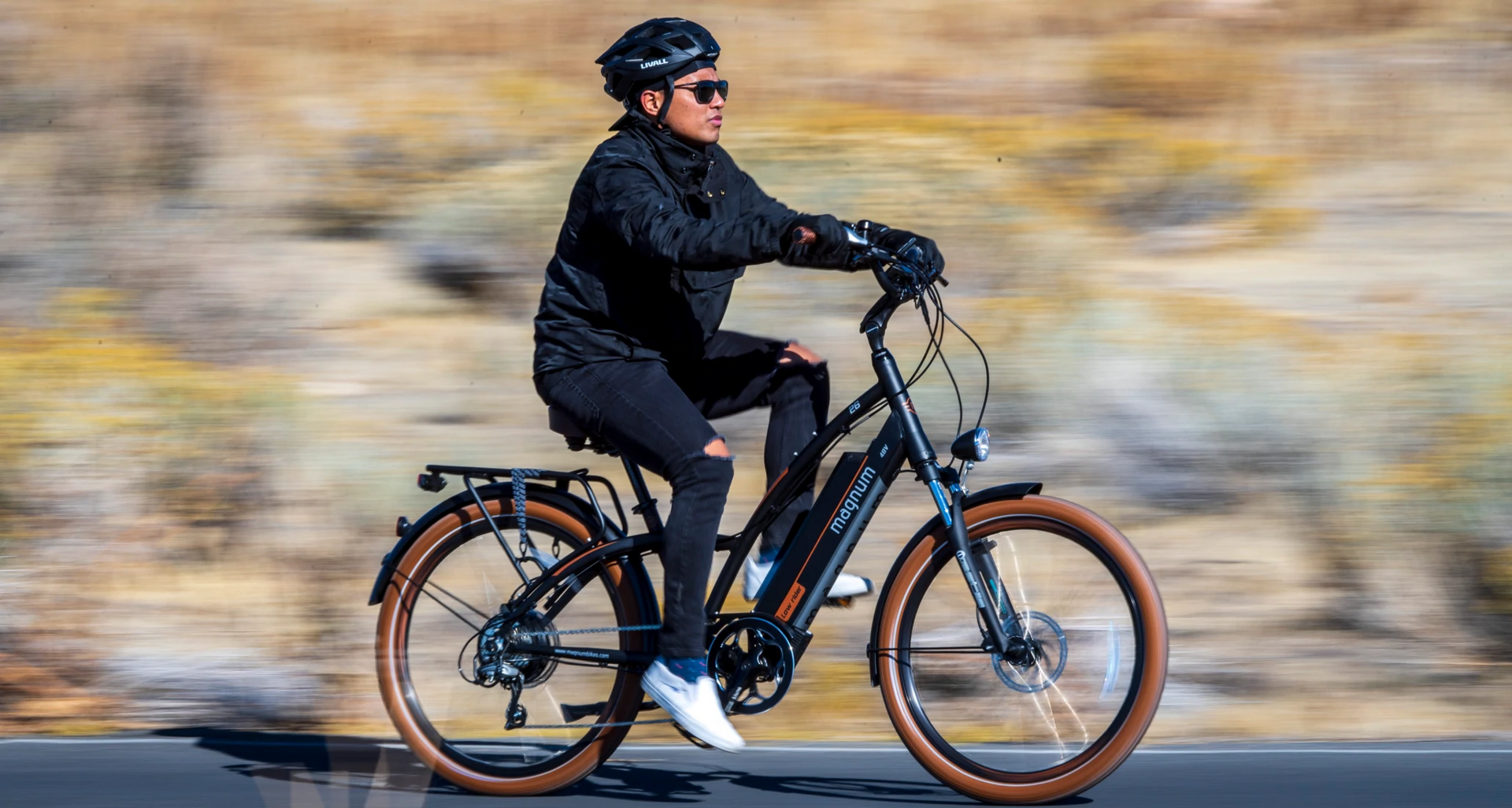E-Bikes California: Where Can I Ride?
From the beaches to the mountains, the forests to the lake trails, California is an amazing state. But you can’t ride your e-bike just anywhere in CA. There are state and local regulations to contend with, and rules can even vary from trail to trail.
Here’s everything you need to know about e-bike laws and the best e-bike trails in The Golden State.
If you already know what info you’re looking for, jump ahead:
What Are The Best E-Bike Trails And Parks In California?
Are E-Bikes Legal In California?
Are There E-Bike Incentive Programs In California?
Where Can I Find Magnum Bikes In California?
What Are The Best E-Bike Trails And Parks In California?
It’s hard to pick the best e-bike trails in such a big and beautiful state, so we broke it down by region. Here are our top picks for northern, central, and southern California e-bike trails.
Joe Rodota Bike Trail in Sonoma County
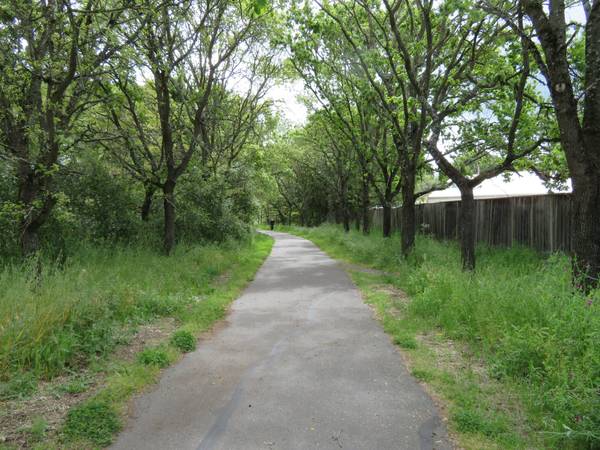
Joe Rodota Bike Trail. Source: Wikimedia Commons
Why We Love It
This 8.5-mile paved trail offers glimpses of farmlands, mountains, and the Laguna de Santa Rosa wetlands. It connects Santa Rosa and Sebastopol.
There are about a dozen access points to jump off and on the trail, including several with free parking for hybrid commuting.
When To Visit
The Joe Rodota Trail is open from sunrise to sunset all year round.
Those are pretty generous hours, but there’s more: Sonoma County Parks allows commuters to ride in the dark, too.
That’s a big help for winter commutes when the sun doesn’t rise until almost 7:30 am and sets before 5:00 pm.
Which E-Bike Classes Are Allowed?
Class 1: Maximum pedal-assisted speed of 20 mph. No throttle permitted.
Only Class 1 e-bikes are allowed on the Joe Rodota Trail. This is the standard for all trails in Sonoma County Regional Parks.
Monterey Bay Coastal Recreation Trail in Monterey County
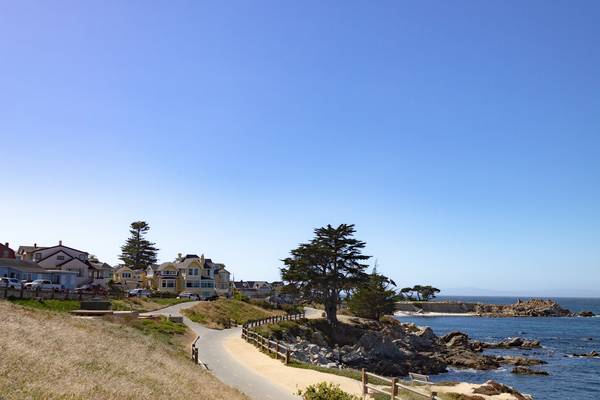
Monterey Bay Coastal Recreation Trail. Source: Wikimedia Commons
Why We Love It
Spanning 18 miles from Monterey through Pacific Grove and up north to Castroville, the Monterey Bay Coastal Recreation Trail offers stunning ocean views and plenty of activities, including e-bike rentals, kayak rentals, and more.
But take note: the City of Monterey prohibits bike riding anywhere signs are posted (excluding designated bikeways like the Coastal Trail).
So if you’re stopping to explore downtown or the famous Monterey Bay Aquarium, don’t forget your e-bike locks!
When To Visit
The trail is open year-round, and the weather is typically mild, though it can get chilly and misty at times.
We didn’t find official operating hours listed, but parks in the area are open between 6:00 am and 10:00 pm.
Which E-Bike Classes Are Allowed?
Class 1: Maximum pedal-assisted speed of 20 mph. No throttle permitted.
Class 2: Maximum pedal-assisted or throttle speed of 20 mph.
Slow down! As reported in 2020, the city of Pacific Grove has restricted speed limits along its portion of the Monterey Bay Coastal Recreation Trail to 12 mph.
The City of Monterey asks riders to avoid riding in an unsafe or reckless manner.
Class 3 e-bikes (those with assisted speeds up to 28mph) are prohibited on the trail.
Rincon Bike Trail in Ventura County
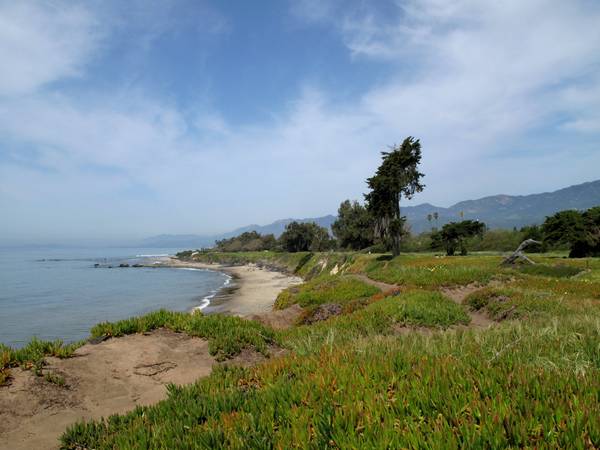
Carpinteria State Beach. Source: Wikimedia Commons
Why We Love It
This paved bike path runs alongside scenic Highway 101, offering ocean views most of the way. Spanning 10 miles of coastline, the Rincon Bike Trail does meet up with the highway at some stretches, but wide shoulders make this a pretty comfortable ride.
There aren’t many options for pit stops on this trail, so plan on eating at either end of the trail in Carpenteria or Ventura — or both!
When To Visit
Ventura County has beautiful weather all year, so you can’t go wrong. We didn’t find hours listed for this trail, but it’s typically safe to plan on access from dawn to dusk.
Which E-Bike Classes Are Allowed?
We didn’t find regulations on which e-bike classes are allowed on this trail. Since the trail runs through Carpinteria State Beach, we recommend following California’s e-bike regulations for State Parks: Class 1 e-bikes only.
Are E-Bikes Legal In California?
Thankfully, CA is an e-bike-friendly state. Within towns and on roads, many counties and cities let you ride your e-bike just about anywhere that a regular bike is allowed.
Note that bikes often aren’t allowed on sidewalks, which means that e-bikes often aren’t allowed there, either!
But when it comes to national parks and other federal lands, the rules stay the same nationwide: e-bikes of any class are considered motorized vehicles and are only allowed on motorized trails on federal land.
Here are the main things to know about riding e-bikes in California:
Do I Need a Driver’s License For E-Bikes In California?
The State of California does not require a license, registration, or insurance to operate an e-bike.
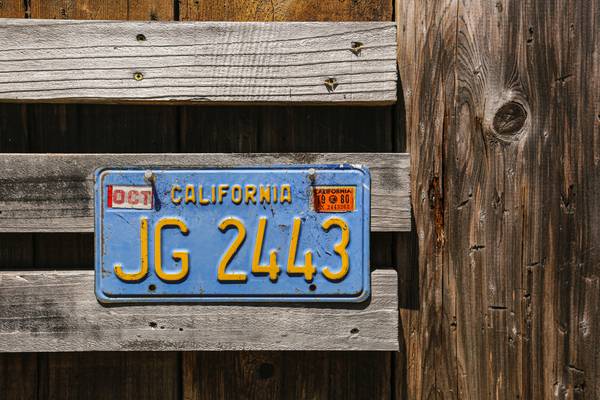
No driver’s license or license plates are required for e-bikes in California. Image Source: Unsplash
Restrictions for Class 3 E-Bikes
According to the California DMV, no one under the age of 16 can operate a Class 3 e-bike (maximum pedal-assisted speed up to 28mph, with or without a throttle).
Class 3 e-bikes may not be allowed in bike lanes, depending on local laws.
All Class 3 riders must wear helmets. Also, Class 3 e-bikes typically aren’t permitted to carry passengers.
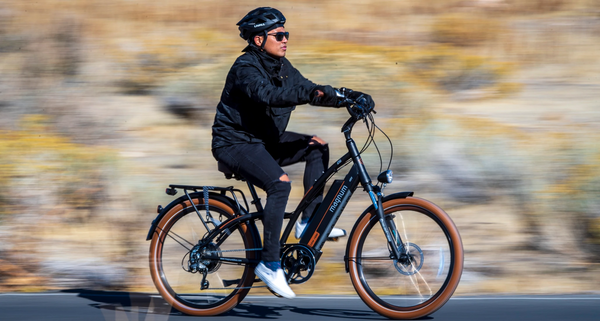
Helmets are required for Class 3 e-bikes in California. Pictured: Magnum Low Rider
State Parks Are Mostly Limited to Class 1 E-Bikes
In general, only Class 1 e-bikes are allowed to be used on trails in state parks — but other classes are allowed in some cases. Click for California State Parks guidance.
California Recognizes 3 E-Bike Classes And 4 Bike Lane Classes
“E-bike classes” can get a little confusing in California, because while the state recognizes the common e-bike classes (Class 1, Class 2, and Class 3 e-bikes), their transportation department also has a system for categorizing bike lanes and bike paths.
Unfortunately, that system also uses “classes” — and they aren’t related to the 3 e-bike classes at all.
The classes were developed to distinguish between different purposes or styles of bike path. The only connection between them is that Class 3 e-bikes aren’t typically allowed on Class 1 bikeways.
For full details, see the CalTrans Highway Design Manual (Chapter 1000).
And since regulations vary so much from region to region, always play it safe: check with your local government or visitor’s center before hitting the streets.
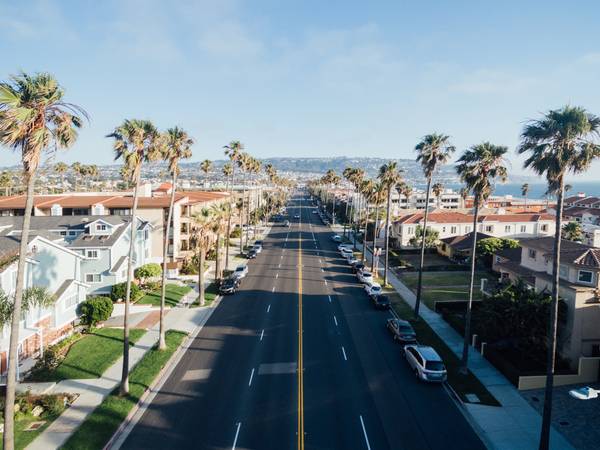
Redondo Beach, CA. Source: Unsplash
Are There E-Bike Incentive Programs In California?
In addition to any statewide incentive programs, many counties and cities offer regional incentive programs for e-bike purchases. These programs may be run by power districts, air quality management authorities, local governments, advocacy groups, and more.
These programs usually have financial or quantity-based limits, so they don’t run indefinitely — but new e-bike incentive programs also pop up regularly. Learn more about incentive programs.
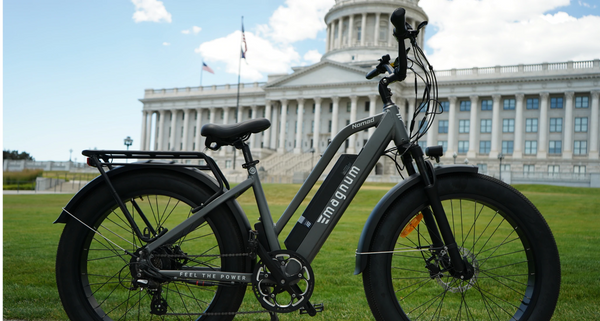
Does your local government or other regional organization offer e-bike purchase incentives? It’s worth a look! Pictured: Magnum Nomad
The Bay Area, Monterey Bay, San Diego County, Sonoma County, and the South Coast (including LA) are just some of the regions that have offered incentive programs to date.
In fact, as of this writing, California ranks 1st in the nation for total number of e-bike incentive programs proposed, active, and closed over the years — nearly 30 total programs as of early 2023! We expect that to keep trending up.
California’s e-bike incentive programs have been structured in many ways, including old vehicle trade-ins exchanged for e-bike vouchers, loans for e-bike purchases, lending libraries of e-bikes for the community, partial purchase subsidies, ride-to-won programs, and more.
Where Can I Find Magnum Bikes In California?
Ready to hit these trails and more on a new e-bike? We’ve got you covered.
Magnum Bikes can be found in over 250 authorized dealers and flagship stores across the US.
And we have partnerships with dozens of e-bike dealers across California, including our very own Magnum flagship store in Encinitas, conveniently located on South Coast Highway 101 — just three blocks east of the ocean.
Not near Encinitas? No problem! Visit any of our Magnum Authorized Dealers in California.

The Magnum Bikes Retail store on Highway 101 in Encinitas.
E-Bikes California FAQs
Here’s what people frequently want to know about e-bikes in California.
Are Electric Bikes Allowed On Sidewalks In California?
It’s beautiful weather most of the time, so Californians want to ride wherever and whenever they can!
But the rule is: if you aren’t allowed to ride a regular bicycle on the sidewalk in your town, you can’t ride an e-bike on it, either. That’s the case in many places.
Luckily, there are tons of great bike paths and e-bike trails all over the state! Who needs sidewalks?
Are E-Bikes Allowed On California Beaches?
This will depend on local regulations. E-bikes and regular bikes are often banned from boardwalks, sidewalks, and pedestrian-only pathways near beaches, but we don’t see much about riding in the sand.
The best rule of thumb is that if a regular bicycle isn’t permitted on the beach in your area, an e-bike won’t be, either.
We strongly recommend Fat Tire e-bikes for more comfort and traction on sand. Bikes with narrower tires will have a really hard time getting traction and keeping you moving on loose sand.
Not up for a sandy adventure? There are many places throughout California where you can ride alongside the beach. Bikeways like the Rincon Bike Trail in Ventura County let you ride the coastline for miles.
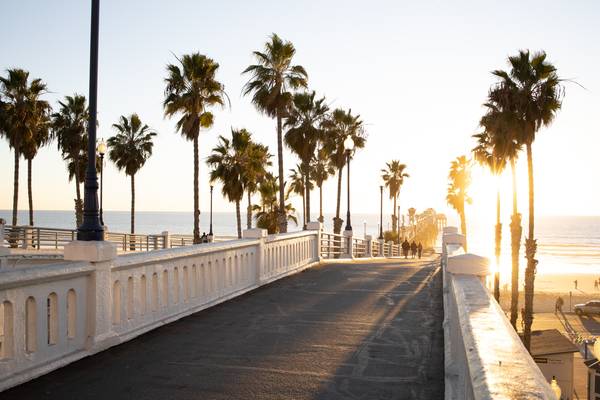
E-bikes and other bicycles are often prohibited on piers, but there are usually great multi-use paths nearby. Pictured: Oceanside Pier. Image Source: Unsplash
Do Electric Bikes Need A License Plate In California?
Licenses and license plates are not required for e-bikes in the state of California.
The only exceptions are Class 4 e-bikes, with maximum assisted speeds over 28mph.
These are typically considered mopeds and have unique licensing, registration, and insurance requirements in California.
So what’s your favorite place to ride in CA?
